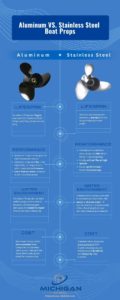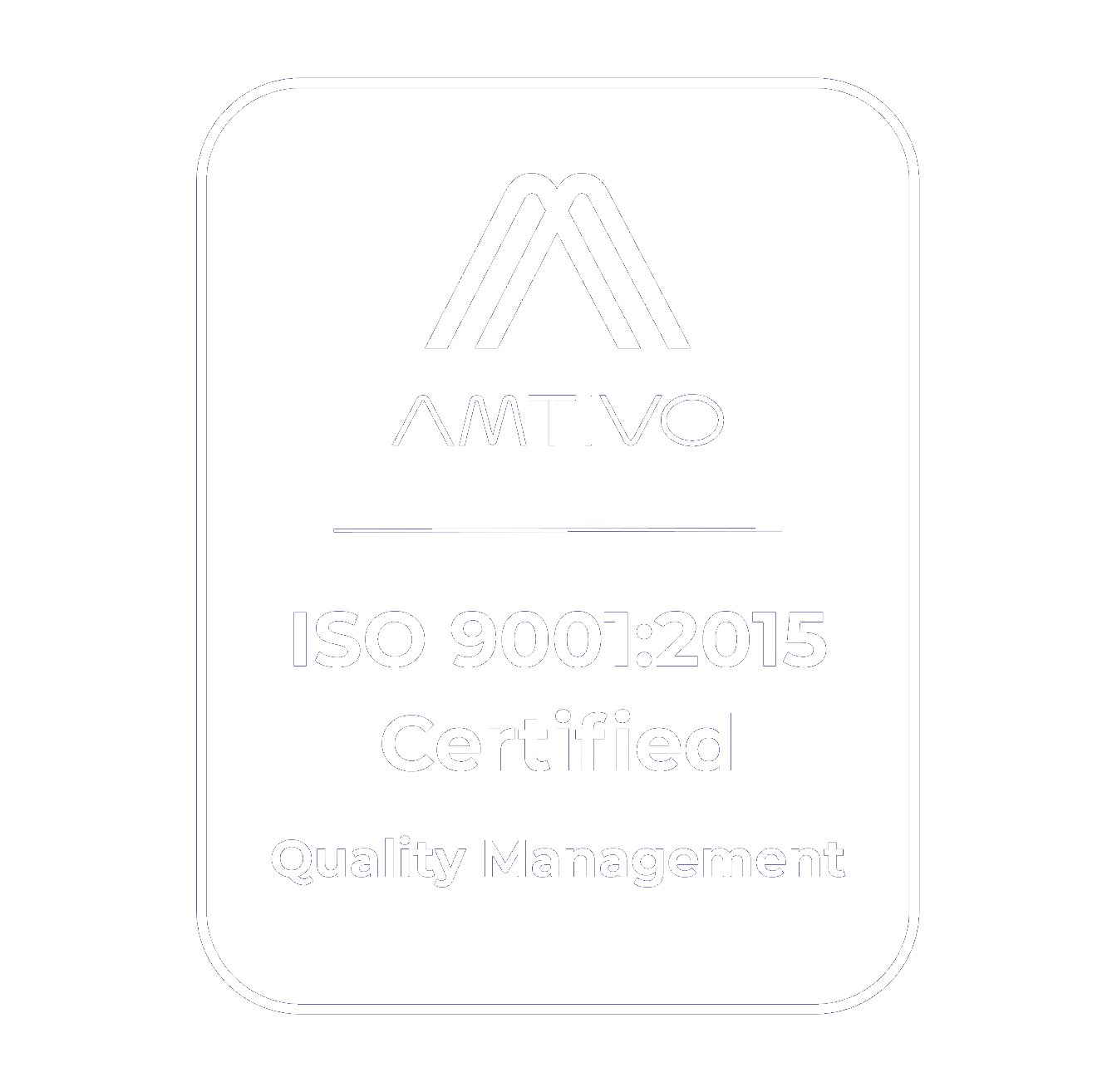Blogs
Owning a boat can be an expensive undertaking. When something breaks, your heart might sink at the repair shop’s estimate to replace it. That’s especially true when there’s a problem with your propeller.
At Michigan Wheel, we understand that there are a lot of misconceptions when it comes to boat prop repair. To help clear things up, we’ll answer some frequently asked questions about outboard propeller repair. We’ll also dive into the difference between prop material, specifically aluminum versus stainless steel props, and what they mean in terms of likelihood of repair.
Is it hard to Repair a Boat Propeller?
If you look at an outboard boat prop, you might already know the answer to this question. Boat Propellers are very intricate, brittle, and difficult pieces to work with. An outboard propeller repair is very difficult, as it requires precise straightening, welding, and reconfiguring of the prop. That being said, the prop repair process certainly isn’t as easy as slapping on some duct tape and calling it a day, and the repair cost typically isn’t cheap but could be more cost efficient than replacing it. If your prop has been damaged, it’s vital that you have your prop repaired because even a minor issue with it can severely affect boat performance.
Props go through a ton of stress underwater and they’re the sole reason your boat moves at all. An improperly repaired propeller will ruin your boating experience and could leave you stranded in the middle of your ride. Below, we will outline some tips for proper propeller maintenance & care, which can help you (and your propeller) in avoiding reduced performance due to damage and the hefty repair prices that can come with prop damage.
Best Practices for Propeller Care & Preventative Maintenance
I.) General Maintenance
It’s certainly easier to clean and repair most complex items piece-by-piece, and the same applies for a boat prop. The first step in cleaning or repairing your boat propeller is to separate your propeller from the prop shaft.
Doing this allows you to see if there’s anything caught up in the prop shaft, such as a fishing line. If you see a fishing line, or anything foreign upon separating the propeller from the prop shaft, carefully remove it. The National Marine Propeller Association (NMPA) recommends doing this after every second or third trip.
Once that is done, move on to examining your prop shaft and seal. It is vital to check your seal for any damage because it is the seal that prevents water from entering the gear case – which is crucial when it comes to your boat’s motor running properly. If all looks good with your prop shaft and seal, you can put your propeller back together. Ensure that you are reapplying grease to it to keep the area lubricated and running smoothly. In addition to re-greasing the propeller when putting it back together, make sure the propeller nut is tightly secured and that you’ve used a new cotter pin to keep everything in place.
II.) Carry a Spare Prop
Similar to how you always keep a spare tire in your car, you should always keep a spare propeller in your boat, since the alternative is getting towed back to shore. Your spare prop doesn’t even necessarily have to be the most high-quality stainless steel prop, it can simply be one that will suffice just for your ride back home. Most people buy a used prop that is the correct size just to have as a spare. However, it’s important to note that it is tricky to change a boat prop depending on how rugged the weather is. In the event that you’re caught in rough water, it is smarter to go ahead and call for the tow.
III.) Repair or Replace Bent Props
If you either hit a hefty sandbar or hit a large object that causes your propeller to bend, it’s important to get it taken care of right away. Propeller blades that are bent are bad for your boat for two reasons: 1) your engine will not run as well with bent blades, and 2) bent prop blades cause an imbalance in your boat, which can lead to catastrophic damage to internal parts of your boat – such as the transmission. Something to note in repairing is to make sure the repair technician does not file down the prop blade edges, as that will reduce its diameter.
So, what should you do if you think you’ve bent your prop blades? First, give your prop a good visual examination to assess any damage that you can spot with the eye, in addition to measuring the blade placements. You’ll also want to check on the prop shaft and assess it for any damage. Most importantly, though, you should take your prop to a professional team, as they have experience evaluating prop damage, as well as the expertise to get your prop back in tip-top shape.
A Prop Shop will be able to tell you whether your prop is repairable or if the damage has necessitated buying a new prop entirely.
Does Prop Material Matter?
We can’t stress this enough: the material of your boat propeller is significant when it comes to whether you can repair the prop.
In our experience, die-cast props usually can’t be repaired. They aren’t strong enough and typically break apart during the straightening process. On top of that, they’re especially brittle and hard to work on. Bad news here is that a lot of original equipment propellers are made of die-cast materials. However, you’re in luck if your prop is made of sand-cast aluminum, as these propellers are stronger and can undergo the full repair process without failing.
So, when it comes to choosing between aluminum and stainless steel propellers, what things should you be considering?
Keep reading, because below we will outline some key differences between stainless steel and aluminum props, alongside considerations you should make when choosing between the two.
Differences between Aluminum and Stainless Steel Props

I. Affordability & Durability
Aluminum propellers cost far less than stainless steel – often costing only a fraction of what a stainless steel prop costs. However, affordability is a double-edged sword when it comes to durability and longevity; an aluminum prop isn’t nearly as strong as a stainless steel prop. This is because a stainless steel prop has five times more stress tolerance when compared to an aluminum prop, meaning its blades are stronger, thus less prone to damage from minor impacts or run-ins with mud bottoms. As a result, an aluminum prop would be far more likely to sustain significant damage if it were struck. So, while you may initially pay less with an aluminum prop, you could potentially end up spending just as much in the future on prop repair costs if you aren’t careful.
II. Performance Level
If you’re looking to enhance the performance of your boat, a stainless steel propeller is the way to go. Stainless props have thinner (and far more durable) blades than aluminum props, and these thinner blades reduce drag, often enhancing acceleration and speed as a result. On the other hand, aluminum props’ thicker blades increase drag, slowing your boat down and reducing fuel efficiency.
III. Water Environment
How and where you’re using your boat is another factor to consider when choosing between an aluminum or stainless steel propeller. If you are often in shallow water, and more prone to hit objects or the sand itself with your boat propeller, it’s in your best interest to go with a stainless steel prop due to its likelihood of withstanding damage, as mentioned above.
Key Considerations in Choosing Propeller Material
Now that you know the key differences between aluminum and stainless steel props, you have a decision to make. While there is no ‘right’ choice, there certainly are tradeoffs that should be considered case by case (or boat by boat). Realistically, your decision is based on how each prop will impact your boat’s performance. You should ask yourself this series of questions when you are deciding on the right propeller material for your boat.
- Is your boat more often in a deep or shallow water environment?
- What is the level of performance you’re looking for?
- How and what do you use your boat for?
- How much are you willing to spend?
Marine Propeller Repair – Can Anyone do it?
It’s worth mentioning that it takes a highly skilled prop shop to be able to fix an outboard propeller in a timely manner. There’s a lot of engineering that goes into the propeller design and repairing them is an arduous and skillful process.
If you trust the wrong person with this repair, you’ll waste a ton of time and money as they ruin your prop. We always suggest taking your propeller to an authorized propeller repair station if you want the best results. Luckily, you will find options for prop repair scattered across the country. The National Marine Propeller Association even provides a directory and interactive map to help you find a member propeller facility near you. Access the directory directly by clicking here, or the map by clicking here.
How Expensive Is an Outboard Prop Repair?
Replacement is much more expensive than a repair. As we mentioned, it’s typically not possible for a die-cast prop to be repaired. However, if you ask us to repair your sand-cast aluminum prop, you can expect to pay about 1/3 or 1/2 the cost of a new propeller. This can mean a lot more money in your pocket at the end of the day that isn’t spent on expensive repair costs. Less severe damage to your prop will translate to even less money that you’ll have to spend on minor repair costs.






